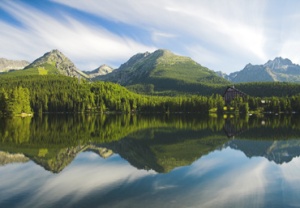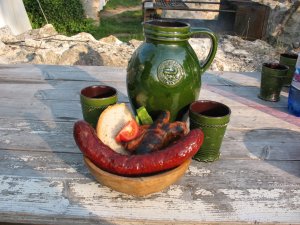![]() In this guest post by Vodník author Bryce Moore, Bryce continues to share his favorite things to see, do, and eat when visiting Slovakia.
In this guest post by Vodník author Bryce Moore, Bryce continues to share his favorite things to see, do, and eat when visiting Slovakia.
What to See
In my last post, I gave a rundown of some of Slovakia’s best castles. But Slovakia’s more than just castles:
Bratislava is the capital of the country. It’s a gorgeous old city, and it’s only 45 minutes away from Vienna–they make excellent cities to tour together. Bratislava has much of the same refined culture that you see in Vienna, but it’s at a fraction of the price. (I once went to the state opera and got box seats for $4. Prices have gone up significantly since then, or course.) Check out the markets in the old square, where craftsmen from around the area come together each day to sell their wares. Great stuff.

Banska Stiavnica is a fascinating old mining city. It’s a drive to get there, but once you arrive, you find a city that’s essentially been left alone for the last few hundred years. (One of the tragedies of many places in Slovakia is that Communists made it a point to tear down or change a lot of the historical landmarks. Banska Stiavnica must not have been deemed important enough to warrant Communist attention.) It’s got mines that are over 700 years old, a series of reservoirs, fantastic old churches–and some of the steepest hills I’ve walked up and down. Bring your hiking shoes! (And make sure to check out the Chateau in St. Anton, a town right next to the city. It’s honestly better than any of the attractions I went to in Vienna. Much more authentic—it really gives you a sense of how the Hapsburgs lived.
If you’re more into nature and the outdoors, head north into the Tatra Mountains. Great skiing, rugged mountains, beautiful streams. You’re set no matter when you visit. Just be ready for not a lot of civilization, and a whole lot of green.
Or, to see how life used to be in Slovakia a long time ago, check out Cicmany. Practically the whole village is an example of folk architecture.
What to Eat
If you’re anything like me, no trip is complete without sampling all the goodies you can get your hands on. Slovakia has plenty of great things to eat. One of the most traditional dishes is halusky–basically potato dumplings with cheese and bacon sauce. Absolute heaven. Their bread is fantastic–go into any bakery and just get a sampling of all they’ve got in there. (Better not be on a carb diet!) I’m also a huge fan of their bacon and spiced sausages. Then again, I’m a fan of bacon and spiced sausages, period. For sweets, try wafer cookies and, of course, ice cream. European ice cream blows American ice cream away. Much richer and smoother.
What to Remember
That’s a quick rundown of some of the highlights. To end, I just wanted to add a few cautions. First up, English isn’t spoken as much as you’d like it to be in the country. A lot of the youth speak it (though they’re naturally a bit intimidated at times, talking to native speakers), but many of the tours will be Slovak-only. They do offer English translations of the tours, typically on pieces of paper you can take around with you to read while the tour is going on, but be prepared to be confused sometimes. That said, most Slovaks I’ve met are very welcoming, and more than happy to work with you to help you get what you want or get to where you want to go.

Second, the country’s infrastructure is not yet up to par with what you might be used to here in the States. The highways don’t connect everywhere yet, and many times, the only way you can get somewhere is by taking smaller roads. Then again, the public transportation is great. You don’t need a car in Slovakia. You can take the bus or train most places you want to go. In fact, public transportation is often a great idea from a financial perspective, too, since gas is really expensive – somewhere around $9/gallon.
If you’re flying into the country, your best bet is Bratislava airport, or perhaps Vienna. You can also fly into Prague and drive, but that’s a good three or four hour trip. Slovakia is part of the EU, so they use the Euro. While most of Europe is pretty expensive compared to America, Slovakia’s prices are still very reasonable these days.
And . . . that about sums it up. I love the country, and I hope more people discover it soon. If you’re going and have some specific questions, shoot me an email or send a tweet my way at @bmoorebooks. I’m happy to help how I can. And if you want a better idea of what it’s like living in Slovakia from an American perspective, give Vodník a read through.
Happy trails!


